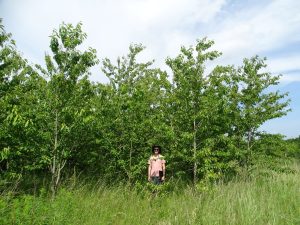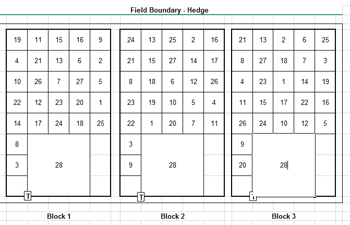Summary
Trees are long-living and slow-growing species that cannot rapidly adapt to large environmental changes. Trees planted today need to be able to thrive in the full range of conditions they will confront in their lifetimes – in some cases over 100 years. As climates are predicted to change rapidly many trees planted now may be poorly adapted to the future.

A new forest management strategy in the UK based on climate matching is currently being suggested to help increase the resilience of our forests.
The following pages present a summary of the experimental design of the provenance trial at Hucking Estate:
Research questions
The experiment aims to address the following questions:
- Considering the 2050 and 2080 climate change scenarios, which planting stock is recommended for woodland establishment in the southeast of Britain?
- As climate change is likely to be an unpredictable process, a mixed-provenance approach may be less risky than planting a single provenance. What is the recommended planting ratio of local compared with non-local provenances to achieve maximum survival and growth rates of a given tree species?
- What is the influence of mixing local and non-local provenances on stand structure and the relative performance of provenance material?
- What is the influence of non-native provenance material on biological diversity? (For example; mycorrhiza or insects, and the incidence of pests and diseases).
- What is the influence of planting mixtures of tree species on the planting success? (For example; relative survival and growth, of native and non-native provenance material).
Contact
Climate matching and provenance choice
Climate matching involves identifying regions that currently have climates we anticipate experiencing in the UK in 50 – 100 years time. On a practical level this enables us to source tree stocks from a different location -different provenances – which may be better adapted than existing genetic stock to future climatic conditions. The planting of mixed provenance and mixed species forests is also considered to be a good management strategy but little is known about its true potential for success in terms of growth, productivity, health and associated biodiversity.
The provenance trial at Hucking in Kent is one of a series of studies that has planted trees from different provenances in order to assess their performance. For each species and provenance planted the project will examine:
- The growth and survival rates
- The phenology (timing of different phases of growth, e.g. bud-burst)
- The incidence of herbivorous insects and other pests/diseases
The results will help to inform future decisions on which species to plant, from where and in which planting configurations.
Provenances and species choice
Climate matching analysis determined that the climate in Kent projected by models is likely to be similar to that of Northern France in 2050 and to that of specific regions of Central Italy in 2080.
Three tree species native to Britain – Oak, Wild Cherry and Ash – and one naturalised (Sweet Chestnut) were used for the experiment. Seedlings of each species were sourced from nurseries in Kent, Northern France and Southern Italy. Sweet Chestnut was not sourced from Kent as it is a naturalised and not a truly UK native species.
All trees in the experiment were imported and planted prior to the UK outbreak of Chalara fraxinea (Ash Dieback). Ash trees in the project were subsequently checked for the disease and none were found to be infected. Monitoring for the disease is ongoing.
Site and preparation
The site of the trial is located on the Hucking Estate in Kent owned by the Woodland Trust.
The trees were planted on a 2 ha plot of ungrazed pasture on a drift clay soil with flint (typical of the region).
The plot was fenced to protect young trees from rabbits and deer and mowed prior to planting. Layout plans were formulated and marked up.
Planting
A total of 3,780 trees were planted with 2 m spacing in a block design replicated 3 times.
Each block contains 27 individual plots of 36 trees planted in one of the following configurations:
- Single species, single provenance
- Single species, mixed provenance
In addition each block had a further plot containing 288 trees as:
- Mixed species, mixed provenance
Mixed provenance plots were planted in 50:50 and 75:25 ratios. The uneven ratios were chosen to reflect anticipated success rates; for example, since Italian stock was anticipated to perform less well it would not make sense to plant it as the majority species.
Planting took place in February 2011 and all seedlings were protected by vole guards. Any trees that died within the first two years of the experiment were replaced – like for like. The site is regularly mowed and approved herbicide applications made when required.
- PlantingDesign.pdf
(PDF-194K)

Randomised block design of planting at Hucking provenance trial. Blocks indicate the 3 replicates of the experiment. Each numbered square (1-27) represents a plot treatment. Plot 28 represents the area of planting of 288 trees in mixed species/mixed provenance configuration.
Assessments
Every tree on the site is assessed for the following attributes (with specified frequency):
- Survival (spring and autumn)
- Growth – height and diameter (annual)
- Phenology – timing of spring bud burst (weekly May to July) and autumn leaf discolouration (weekly September to November)
- Associated Biodiversity – insect herbivores (annual or biannual)
It is hoped that data collection will be continuing for a minimum of 10 years.
Further information
The Hucking provenance trial forms part of the AdaFor project and is part of an international network of similar experiments entitled TreeDivNet.
Two sister experiments have also been established in the Midlands in partnership with the National Forest Company, the Forestry Commission and Aggregate Industries.
The Hucking trial is jointly sponsored by the Forestry Commission and the European Union within the framework of the European Interreg IV A 2 Mers Seas Zeeën Cross-Border Cooperation Programme.

![]()

Forest Research is grateful to the Woodland Trust for ongoing use of the site and assistance with its maintenance.
